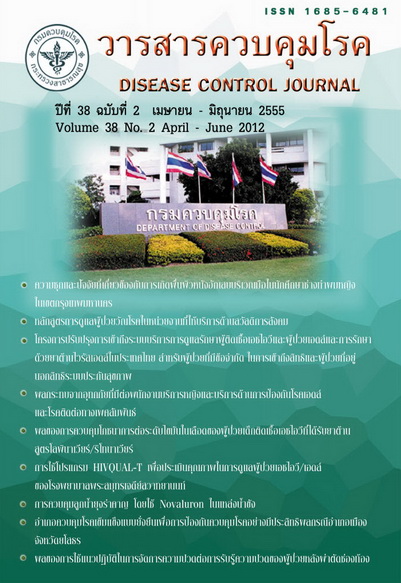National Antiretroviral Access for People with HIV/AIDS, the Extension Phase to Reach Uninsured and Limited Rights Patients
Keywords:
Development of the Extension Phase, HIV/AIDS, Uninsured and Limited Rights PatientsAbstract
Thailand initiated a project to provide ART to people with HIV/AIDS who were un-insured and with limited rights, mostly non-Thai immigrants, in 2006. The project was partially supported by the Global Fund with a target of 2,000 cases. From October 2006 to September 2011, there were 6,148 cases cumulatively received service for the project. Of these, 4,414 cases (71.8 °/o) were non-Thai targeted patients, and 1,734 (28.2 °/o) were Thais. At enrollment, 51.82 °/o of targeted and 37.77 °/o of Thai patients had CD4 cell count equal to or less than 200 cell/mm3. 68.4 °/o of targeted and 37.77 °/o of Thai patients had never received ART before. In September 2011, there were 2,834 targeted cases (64.2 °/o of cumulative targeted patients) and 217 cases of Thais (12.5 °/o of cumulative Thai patients) actively participated in the project. Number of cases treated with first-line regimen among targeted and Thai patients were 2,564 (90.5 °/o) and 165 (76.0 °/o) respectively. ART services provided in this project had been developed based on humanitarian reason in order to reduce morbidity and mortality related to HIV and AIDS. Challenges and recommendations for future development included: (1) Financial support from GFATM would end in 2014, therefore, the provision of sustainable ART service for this targeted patient should be developed. (2) For future plan, attempt to estimate number of needed cases should be made in order to request sufficient resources to implement project. (3) Thai patients were enrolled due to gap during changes in health insurance scheme or fear of losing confidentiality, however, with explanation on the objective of the project, almost Thai cases had been referred out. (4) Since there had been a number of losses to follow up, there should be a study to identify more appropriate means to retain cases for long-term treatment programme.
Downloads
References
2. Thanprasertsuk S, Lertpiriyasuwat C, Chasombat S. Developing a National Antiretroviral Programme for People with HIV/AIDS: The Experience of Thailand. In AIDS in Asia: the challenge ahead. Editor, Jai P Narain, New Delhi. SAGE Publications India Pvt. 2004: 312-322.
3. Chasombat S, Lertpiriyasuwat C, Thanprasertsuk S, Suebsaeng L, Lo Y R. The National Access to Antiretroviral Program for PHA (NAPHA) in Thailand. Southeast Asian J Trop Med Pubic Health. 2006 Jul: 37(4): 704-15
4. เพชรศรี ศิรินิรันดร์ พัชรา เบญจรัตนาภรณ์ อรทัย หรูเจริญพาณิชย์ และ พรทิพย์ เข็มเงิน. รายงาน ความก้าวหน้าระดับประเทศตามปฏิญญาว่าด้วยพันธกรณี เรื่อง เอชไอวี/เอดส์ ประเทศไทย, มกราคม 2551 - ธันวาคม 2552. คณะกรรมการแห่งชาติว่าด้วยการป้องกันและแก้ไขปัญหาเอดส์ 2553 ISBN 978-974-297-922-5
5. Sciortino, R., and Punpuing, S. International Migration in Thailand 2009. Bangkok: International Organization for Migration; International Labour Organization; Joint United Nations Programme on HIV/AIDS; United Nations Development Programme; United Nations Development Fund for Women; United Nations Population Fund; United Nations High Commissioner for Refugees; World Health Organization; United Nations Children's Fund; World Bank; United Nations Country Team in Thailand, 2009.
6. UNHCR Thailand, http://www.unhcr.or.th/th/ node/3. สืบค้นเมื่อ 30 กันยายน 2554
7. สำนักระบาดวิทยา กรมควบคุมโรค. ผลการเฝ้าระวังการติดเชื้อเอชไอวีเฉพาะพื้นที่ประเทศไทย รอบที่ 26 (มิถุนายน 2551). http://www.boe. moph.go.th/files/report/20110407_ 34092086. pdf สืบค้นเมื่อ 26 สิงหาคม 2554
8. โครงการ GF รอบที่ 1 และ RCC http://portfolio.theglobalfund.org / en / Grant / Index / TH A -102- G01-H-00 สืบค้นเมื่อ 26 สิงหาคม 2554
9. หนังสือ กลุ่มโรคเอดส์ สำนักโรคเอดส์ วัณโรค และโรคติดต่อทางเพศสัมพันธ์ ที่ สธ 0424.4/7/GF 2195 ลงวันที่ 14 มิถุนายน 2549 เรื่อง ขออนุมัติโครงการการปรับปรุงการเข้าถึงบริการการดูแลรักษาผู้ติดเชื้อและผู้ป่วยเอดส์และการรักษาด้วยยาต้านไวรัสเอดส์ ปีที่ 3 (1 ตุลาคม 2548 - 30 กันยายน 2549) และแผนดำเนินงานโครงการ
10. สำนักโรคเอดส์ วัณโรค และโรคติดต่อทางเพศสัมพันธ์ กรมควบคุมโรค. แนวทางการดำเนินงานการให้บริการยาต้านไวรัสสำหรับ ผู้ติดเชื้อเอชไอวีและผู้ป่วยเอดส์ ภายใต้การสนับสนุนงบประมาณจากกองทุนโลก ด้านการดูแลรักษา ปีที่ 6 ระยะ RCC. 2552
11. สำนักโรคเอดส์ วัณโรค และโรคติดต่อทางเพศสัมพันธ์ กรมควบคุมโรค. คู่มือการติดตั้งและใช้งาน NAPHA EXTENSION Software. 2552
12. Sixty-First World Health Assembly. Health of migrants. WHA61.17, Agenda item 11.9, 24 May 2008.
Downloads
Published
How to Cite
Issue
Section
License
Articles published in the Disease Control Journal are considered as academic work, research or analysis of the personal opinion of the authors, not the opinion of the Thailand Department of Disease Control or editorial team. The authors must be responsible for their articles.






